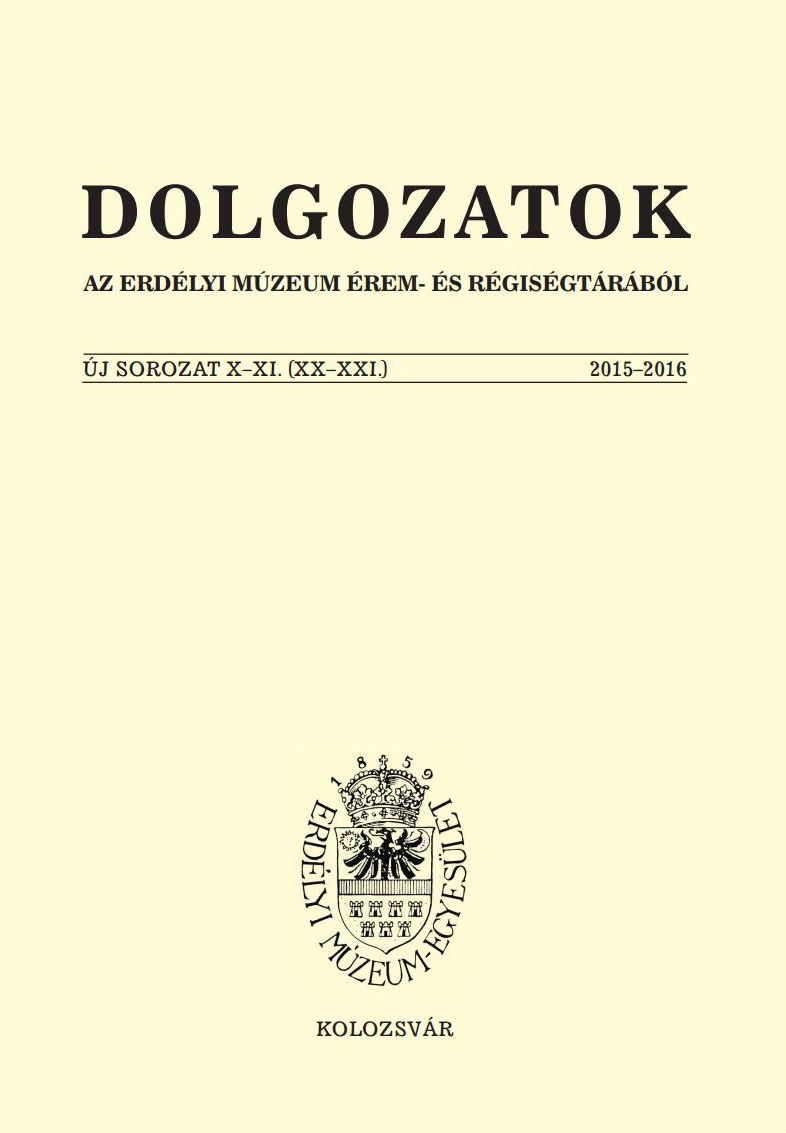Római és kora népvándorlás kori fibulák Simánd határából
Brooches from the Roman and Early Migration Period from the vicinity of Șimand
New data for the repertory of brooches from the Roman and Early Migration Period in the Lower Mureș Valley
Author(s): Norbert KapcsosSubject(s): Archaeology, Ancient World
Published by: Erdélyi Múzeum-Egyesület
Keywords: stray finds; Sarmatian cemetery; Germanic tribes; Almgren 166. type brooch; Vyškov type brooch
Summary/Abstract: In 2014 several bronze brooches were discovered in the vicinity of Șimand (Hungarian: Simánd- Vásárhelypuszta) and donated to the Museum of Arad. The set is composed of knee brooches, brooches with returned foot made of a single (Almgren 158. and 166. types) and of two metal pieces, respectively a Vyškov type brooch (Pl. 1; Pl. 2/1.). The diverse types of Roman age brooches fit in nicely into the brooch repertory of the Mureș–Tisa–Criș region, reflecting an intensive connection between the settlements of the area. Based on the latest studies discussing the origins and dispersion of the Almgren 158. type brooches in the Carpathian basin, some scholars recently have been connecting this phenomenon to the migration wave of the Prezworsk culture towards south which took place after the Marcomannic Wars. Accordingly, the appearance of this type in the Sarmatian Barbaricum is explained by the intense commercial and cultural relations between the Przeworsk culture and the Sarmatians after the end of the second century AD. Accepting this theory, due to the large distance from the source point, as well as the presumed technological import after the acceptance of the style among the Sarmatians, respectively the chronological discrepancy derived from the time passed between the production, the use and the discard of the objects, the earliest possible dating of such artefact in the region discussed can only be from the beginning of the 3rd century AD. The latest analyses regarding the chronology and dispersion of the Almgren 166. type brooches in the Carpathian basin have been conducted in parallel by M. Mączyńska and S. Cociş, but the results of their research partly overlap on the topics of the brooches’ origin and appearance in the Great Hungarian Plain. Projecting the several variants of the Almgren 166. type brooches found in the Great Hungarian Plain on a dispersion map (Pl. 5.), it is visible that such brooches appear most frequently in the northern part of the Great Hungarian Plain – a region cohabited by the communities of the Przeworsk culture and the Sarmatians –, and they appear only in a few cases south or east of this area. This may indicate the objects’ origin. Further analysis of the dispersion of the variants of this type of brooches show the following: – the majority of the variants with notched wire applique can be found on the northern edge of the Great Hungarian Plain, with the exception of two pieces from Szentes-Kistőke and Szentes-Sárgapart; – the variants with simple and notched wire applique appear exclusively in the Trans-Tisa Region; – the Trans-Tisa Region is the sole area of appearance of the Almgren 166. type brooches with double wire appliques, with one exception from Madaras-Halmok; – the needle holder and case with tapped end is characteristic for the northern edge of the Great Hungarian Plain; – artefacts made of silver mainly appear on the northern part of the Great Hungarian Plain, with the exception of two pieces, originating from the Banat and Apulum. From a morphological point of view they are diverse, decorated with a simple or notched wire applique, or the combination of the two; – only two pieces, found in Hortobágy-Poroshát, share such level of similarity that it can be assumed that they were produced in the same workshop. Due to the morphological variety of this type, with the exception of the cases listed above, the dispersion of the variants seems to be accidental. It is hard to separate characteristic pieces for a particular region or to detect workshop districts, mainly because of the relatively easy manufacturing technique of the brooches. By analysing the accompanying finds of the few undisturbed archaeological complexes, the Almgren 166. type brooches can be dated principally between the 3rd and the end of the 4th century AD. The classical variant of the Vyškov type brooch made of bronze seems to be a unique piece in the Carpathian basin, as it combines the features of the Vyškov and Bratei type brooches (Plate 2.). This type of brooch can be dated to the D2–D2/D3 period, and according to the dispersion map (Plate 4/2.), they concentrate mainly in the eastern part of the Carpathian basin, around the known power-centres of the territory inhabited by the Gepids. However, due to the uniform character of the female Germanic costume, it is not possible to clearly connect it ethnically to the Gepids. Still, the lack of such brooches from the territory between the Tisa and Danube rivers, inhabited by the Sarmatians in the discussed period, should be noted.
Journal: Dolgozatok az Erdélyi Múzeum Érem- és Régiségtárából. Új sorozat
- Issue Year: 2016
- Issue No: X-XI
- Page Range: 53-72
- Page Count: 20
- Language: Hungarian

